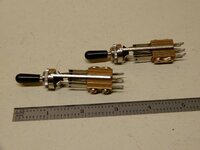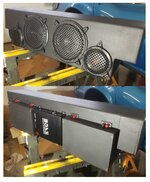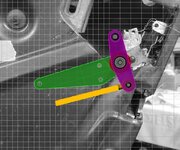You are using an out of date browser. It may not display this or other websites correctly.
You should upgrade or use an alternative browser.
You should upgrade or use an alternative browser.
Long Overdue Progress! Making New Door Panels 12/8/24
- Thread starter BBShark
- Start date
SuperBuickGuy
Well-known member
that's really cool... I wish I had electrical skillz.
My electrical skills are pretty poor really. It takes me forever to figure this stuff out.
If I had the skills you have, I would have been driving this car a long time ago!
If I had the skills you have, I would have been driving this car a long time ago!
SuperBuickGuy
Well-known member
My electrical skills are pretty poor really. It takes me forever to figure this stuff out.
If I had the skills you have, I would have been driving this car a long time ago!
none of my problems are electrical.... there is good reason for that :3rd:
SuperBuickGuy
Well-known member
love it
bobs77vet
Well-known member
looks awesome, nice job
phantomjock
Well-known member
Something that nice looking - ought to sound nice too. Here's hoping it doesn't attract too much "investigation" - else the carpet shows- again! 
I missed what you used for the finish. Looks wrapped - paint? Very well done. Ought to really put the tunes out with the T-Tops off!
Cheers - Jim
I missed what you used for the finish. Looks wrapped - paint? Very well done. Ought to really put the tunes out with the T-Tops off!
Cheers - Jim
The finish is actually Rustoleum Truck Bed Coating. It was way easier than wrapping it with carpet.
This is going into a convertible. An open area is really difficult to get decent sound. You have to move a lot of air and that means power and multiple speakers. I guess I was lucky in that the (bad carpet) area I wanted to cover was large enough to properly "size" the volume required by these speakers.
This is going into a convertible. An open area is really difficult to get decent sound. You have to move a lot of air and that means power and multiple speakers. I guess I was lucky in that the (bad carpet) area I wanted to cover was large enough to properly "size" the volume required by these speakers.
bobs77vet
Well-known member
The finish is actually Rustoleum Truck Bed Coating. It was way easier than wrapping it with carpet.
you know I thought that when I saw it......i used it on the helicopter sheet metal floor and seat and then i sprayed it White. i was impressed with how uniform the spray was.
I could see using that for inside of wheel wells that get beat up by rocks and sand
When I was looking for it, Rustoleum sell s all kinds of specialty paints. They do make a rubberized undercoating.
When you painted over it, did it kind ok level off so that it looked like a dashboard texture? I saw a guy on YouTube do that with a cracked dash. filled the cracks, sprayed truck bed liner and then paint over the top. Looked pretty good on the video
When you painted over it, did it kind ok level off so that it looked like a dashboard texture? I saw a guy on YouTube do that with a cracked dash. filled the cracks, sprayed truck bed liner and then paint over the top. Looked pretty good on the video
SuperBuickGuy
Well-known member
When I was looking for it, Rustoleum sell s all kinds of specialty paints. They do make a rubberized undercoating.
When you painted over it, did it kind ok level off so that it looked like a dashboard texture? I saw a guy on YouTube do that with a cracked dash. filled the cracks, sprayed truck bed liner and then paint over the top. Looked pretty good on the video
look into flocking.... it gives an alcantara look to any solid surface (which is also amazing at hiding repairs)
Next Project: Door latching
I've converted my 1968 latches to 69-up. The difference is the top handles on a 69-up actually unlatch the door whereas a 68 does nothing and you have to push on the door lock cylinder to unlatch the door. Really weird setup, only lasted one year.
The complication is, you can't just swap out the door handles. Not even close.
So, I thought, why not convert it to electric and pop the door open with a switch? Setup a test with a 50lb spring scale using the existing door latching hardware (rods, levers, etc.). I couldn't get the door to unlatch with 50lbs of force!
Latch Pawl with push rod:

Modified Latch Lever Plate
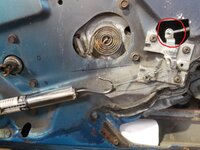
I removed the handle from the plate and used the lever arms to transfer the pull from the spring scale to push the rod.
It does take a lot of force to unlatch the door (~20lbs) if you do it with your thumb. All the lever arms are 1:1 ratio. My assumption is the inefficiency in just about every part of this assembly is at fault. Primarily binding caused by offset loading. This is what causes Corvette latch handles to break. It's also what causes the push rod to bend on just about every C3 I've seen with the door panel off.
Bent Push Rod

My options:
My first instinct was to do this with a door popper solenoid. The problem with that is a solenoid doesn't have constant force through it's travel. That means you don't get full "pulling" force until the plunger is all the way into the solenoid. The latch force is actually highest when the plunger is out.
Then I started thinking I would use a linear actuator and transfer the force through a cable (like all modern cars) that is hooked directly to the latch. The only thing I am unsure of is this. I think I could do this in .25-.5 seconds. I think that is fast enough so that there doesn't appear to be any delay in opening but not really sure. Its probably something that will be pretty easy to mock up.
I think electric latching is done on lots of cars but I don't have a good feel for the timing.
I've converted my 1968 latches to 69-up. The difference is the top handles on a 69-up actually unlatch the door whereas a 68 does nothing and you have to push on the door lock cylinder to unlatch the door. Really weird setup, only lasted one year.
The complication is, you can't just swap out the door handles. Not even close.
So, I thought, why not convert it to electric and pop the door open with a switch? Setup a test with a 50lb spring scale using the existing door latching hardware (rods, levers, etc.). I couldn't get the door to unlatch with 50lbs of force!
Latch Pawl with push rod:

Modified Latch Lever Plate

I removed the handle from the plate and used the lever arms to transfer the pull from the spring scale to push the rod.
It does take a lot of force to unlatch the door (~20lbs) if you do it with your thumb. All the lever arms are 1:1 ratio. My assumption is the inefficiency in just about every part of this assembly is at fault. Primarily binding caused by offset loading. This is what causes Corvette latch handles to break. It's also what causes the push rod to bend on just about every C3 I've seen with the door panel off.
Bent Push Rod

My options:
My first instinct was to do this with a door popper solenoid. The problem with that is a solenoid doesn't have constant force through it's travel. That means you don't get full "pulling" force until the plunger is all the way into the solenoid. The latch force is actually highest when the plunger is out.
Then I started thinking I would use a linear actuator and transfer the force through a cable (like all modern cars) that is hooked directly to the latch. The only thing I am unsure of is this. I think I could do this in .25-.5 seconds. I think that is fast enough so that there doesn't appear to be any delay in opening but not really sure. Its probably something that will be pretty easy to mock up.
I think electric latching is done on lots of cars but I don't have a good feel for the timing.
SuperBuickGuy
Well-known member
if you use the tab the outside door lock is attached to, most solenoids will pull that.... worst part about that inside latch is there is so much play in it that even if you can pull hard enough, it may not be enough travel.
bobs77vet
Well-known member
When I was looking for it, Rustoleum sell s all kinds of specialty paints. They do make a rubberized undercoating.
When you painted over it, did it kind ok level off so that it looked like a dashboard texture? I saw a guy on YouTube do that with a cracked dash. filled the cracks, sprayed truck bed liner and then paint over the top. Looked pretty good on the video
it really had the same texture as before just a different color, i used the black and then top coated it with white.
it did make a nice texture finish but really its what you see now on your speaker box with a different color top coat. i could see it covering most defects underneath if they had at least a 400 level of smoothness to them. maybe even rougher if its not a straight panel in the sun and its a matte finish maybe even satin.
vette427sbc
Well-known member
......
Then I started thinking I would use a linear actuator and transfer the force through a cable (like all modern cars) that is hooked directly to the latch. The only thing I am unsure of is this. I think I could do this in .25-.5 seconds. I think that is fast enough so that there doesn't appear to be any delay in opening but not really sure. Its probably something that will be pretty easy to mock up.
I think electric latching is done on lots of cars but I don't have a good feel for the timing.
Keep in mind that if youre using the interior handle linkage to open the door, the actuator/ popper is going to have to move the interior handle as well, adding more force required to move the whole assembly. Also, without a spring to return a rack-style linear actuator, you will have to program them to return to the home position.
One more note as a car audio guy... assuming the bigger 10" speakers you installed are setup to play ~100hz and below, they will blow out/distort your smaller speakers being installed in the same airspace. If you have them all playing the same frequencies then this is less of a concern. Subs rely on a specific volume of air/pressure to control the cone. When the sub moves its going to move the cone of the smaller speaker with it.
If you push the latch pawl (circled), aligned with the pivot, the force to unlatch is reduced to pretty manageable levels because you aren't twisting the latch pawl (which makes it bind). The other problem is the stock setup uses a push rod that transmits force to the latch pawl about an inch off center.
So I am going to make a lever that pushes the latch pawl that will not bind (force is not off center) and that lever will be pulled, not pushed. For the interior handle I want to operate that with a cable (pulling) and that cable would attach to the lever. The attachment would be slotted so that the actuator will not operate the handle. Also the handle will probably be switched to trigger the actuator so that the interior handle is an "emergency" method of opening the door if there is an electrical failure.
I am using a latching relay to extend/retract the actuator with a momentary switch input.
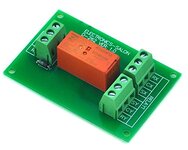
What might be a little weird about this setup is that there will be some delay between push the button on the door and unlatching. Right now I think I can do this in 1/4 second depending on relay latching speed etc. 1/4 second is pretty fast and I will mock it up first.
The speakers are chambered so that the subwoofers are isolated from the 6 1/2" speakers and only the subwoofers are powered by the amp. The 6 1/2 are powered by the stereo rear speakers. The volume needed was .2 cu.ft. (6 1/2") and .7 cu ft (10") for each (unported). It was a tight fit to get that much space and still fit the stowed convertible top in.
So I am going to make a lever that pushes the latch pawl that will not bind (force is not off center) and that lever will be pulled, not pushed. For the interior handle I want to operate that with a cable (pulling) and that cable would attach to the lever. The attachment would be slotted so that the actuator will not operate the handle. Also the handle will probably be switched to trigger the actuator so that the interior handle is an "emergency" method of opening the door if there is an electrical failure.
I am using a latching relay to extend/retract the actuator with a momentary switch input.

What might be a little weird about this setup is that there will be some delay between push the button on the door and unlatching. Right now I think I can do this in 1/4 second depending on relay latching speed etc. 1/4 second is pretty fast and I will mock it up first.
The speakers are chambered so that the subwoofers are isolated from the 6 1/2" speakers and only the subwoofers are powered by the amp. The 6 1/2 are powered by the stereo rear speakers. The volume needed was .2 cu.ft. (6 1/2") and .7 cu ft (10") for each (unported). It was a tight fit to get that much space and still fit the stowed convertible top in.
SuperBuickGuy
Well-known member
you're building new door panels?
Latest posts
-
-
-
-
-
Was member years ago dropping by to say hello.
- Latest: crazyhorse
-
-
-
-
-

